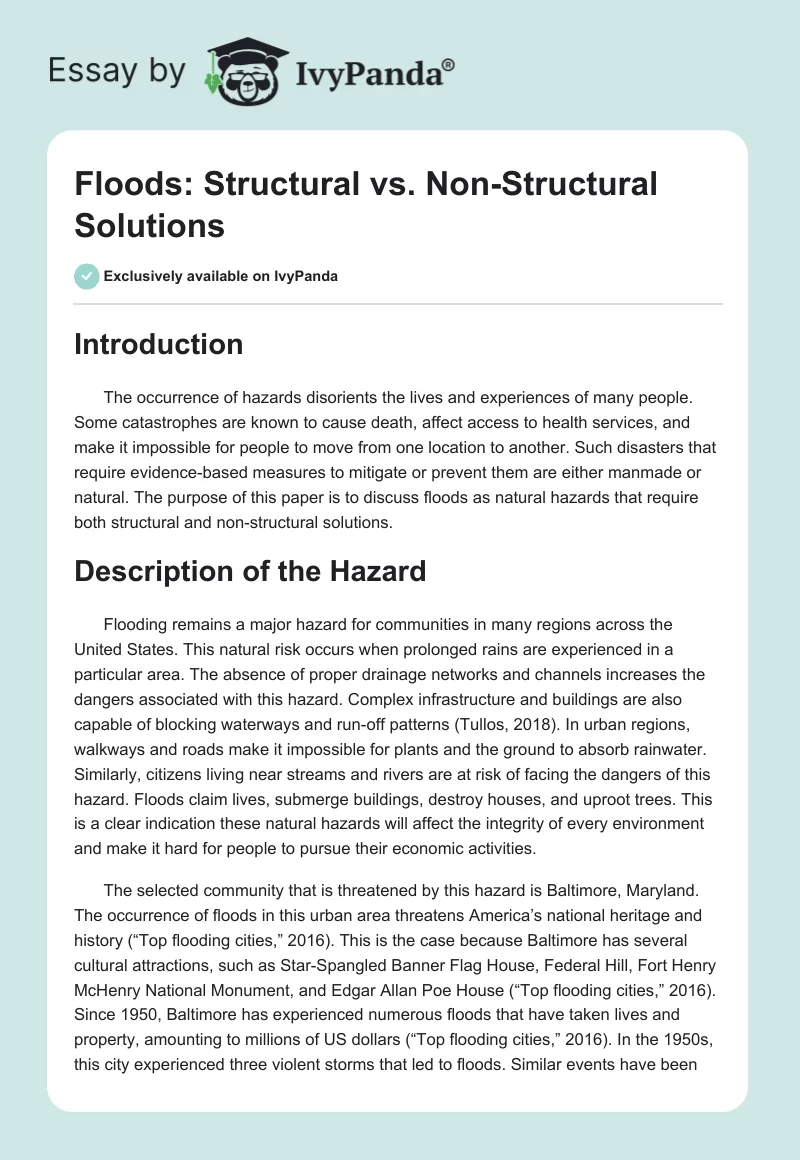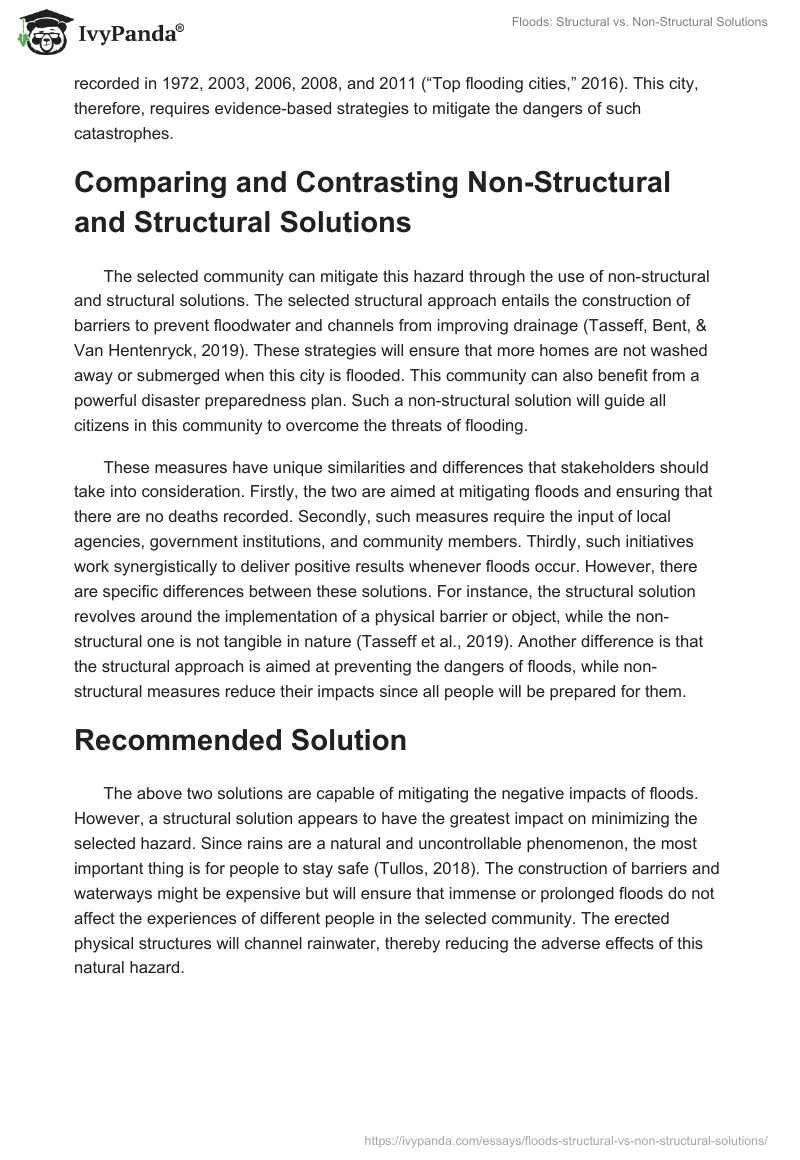Introduction
The occurrence of hazards disorients the lives and experiences of many people. Some catastrophes are known to cause death, affect access to health services, and make it impossible for people to move from one location to another. Such disasters that require evidence-based measures to mitigate or prevent them are either manmade or natural. The purpose of this paper is to discuss floods as natural hazards that require both structural and non-structural solutions.
Description of the Hazard
Flooding remains a major hazard for communities in many regions across the United States. This natural risk occurs when prolonged rains are experienced in a particular area. The absence of proper drainage networks and channels increases the dangers associated with this hazard. Complex infrastructure and buildings are also capable of blocking waterways and run-off patterns (Tullos, 2018). In urban regions, walkways and roads make it impossible for plants and the ground to absorb rainwater. Similarly, citizens living near streams and rivers are at risk of facing the dangers of this hazard. Floods claim lives, submerge buildings, destroy houses, and uproot trees. This is a clear indication these natural hazards will affect the integrity of every environment and make it hard for people to pursue their economic activities.
The selected community that is threatened by this hazard is Baltimore, Maryland. The occurrence of floods in this urban area threatens America’s national heritage and history (“Top flooding cities,” 2016). This is the case because Baltimore has several cultural attractions, such as Star-Spangled Banner Flag House, Federal Hill, Fort Henry McHenry National Monument, and Edgar Allan Poe House (“Top flooding cities,” 2016). Since 1950, Baltimore has experienced numerous floods that have taken lives and property, amounting to millions of US dollars (“Top flooding cities,” 2016). In the 1950s, this city experienced three violent storms that led to floods. Similar events have been recorded in 1972, 2003, 2006, 2008, and 2011 (“Top flooding cities,” 2016). This city, therefore, requires evidence-based strategies to mitigate the dangers of such catastrophes.
Comparing and Contrasting Non-Structural and Structural Solutions
The selected community can mitigate this hazard through the use of non-structural and structural solutions. The selected structural approach entails the construction of barriers to prevent floodwater and channels from improving drainage (Tasseff, Bent, & Van Hentenryck, 2019). These strategies will ensure that more homes are not washed away or submerged when this city is flooded. This community can also benefit from a powerful disaster preparedness plan. Such a non-structural solution will guide all citizens in this community to overcome the threats of flooding.
These measures have unique similarities and differences that stakeholders should take into consideration. Firstly, the two are aimed at mitigating floods and ensuring that there are no deaths recorded. Secondly, such measures require the input of local agencies, government institutions, and community members. Thirdly, such initiatives work synergistically to deliver positive results whenever floods occur. However, there are specific differences between these solutions. For instance, the structural solution revolves around the implementation of a physical barrier or object, while the non-structural one is not tangible in nature (Tasseff et al., 2019). Another difference is that the structural approach is aimed at preventing the dangers of floods, while non-structural measures reduce their impacts since all people will be prepared for them.
Recommended Solution
The above two solutions are capable of mitigating the negative impacts of floods. However, a structural solution appears to have the greatest impact on minimizing the selected hazard. Since rains are a natural and uncontrollable phenomenon, the most important thing is for people to stay safe (Tullos, 2018). The construction of barriers and waterways might be expensive but will ensure that immense or prolonged floods do not affect the experiences of different people in the selected community. The erected physical structures will channel rainwater, thereby reducing the adverse effects of this natural hazard.
Implementation Plan
The implementation of the proposed structural solution requires a model that will not affect community resiliency. The first step is ensuring that the required stones or bricks are locally available. During this phase, stakeholders should identify areas where such channels and barriers should be constructed. The second stage is acquiring resources from community members and government agencies. Some of these requirements will include cement and gravel. Members of the community can show interest by volunteering to deliver positive results. The third phase of the implementation process is that of constructing the targeted structures. During this stage, locally available resources and manpower will be used to ensure that the process is sustainable (Son, Baek, Ban, & Ha, 2015). Such structures should be informed by the nature and intensity of floods recorded in the selected community. Continuous monitoring and improvement is the last phase that will support the delivery of the intended results.
Conclusion
The above discussion has revealed that natural disasters can affect the experiences and lives of many people. The case of Baltimore explains why communities should implement structural and non-structural solutions to address similar disasters. While the paper has identified physical barriers as the best choices for dealing with floods, people in rural and urban areas should embrace and support training and preparedness programs since they can also mitigate different hazards.
References
Son, C., Baek, J., Ban, Y., & Ha, S. (2015). The effects of mitigation measures on flood damage prevention in Korea. Sustainability, 7(12), 16866-16884. Web.
Tasseff, B., Bent, R., & Van Hentenryck, P. (2019). Optimization of structural flood mitigation strategies. Water Resources Research, 55(2), 1490-1509. Web.
Top flooding cities in the U.S. (2016). Web.
Tullos, D. (2018). Opinion: How to achieve better flood-risk governance in the United States. Proceedings of the National Academy of Sciences of the United States of America, 115(15), 3731-3734. Web.


